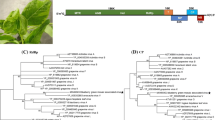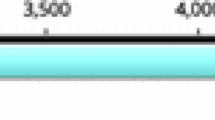Abstract
New virus-like sequences, TvAQ7 and TvP15, were found in a Japanese grapevine accession of OKY-AQ7 (cv. Aki Queen) and of OKY-P15 (cv. Pione) by nested RT-PCR to simultaneously amplify a segment of the RNA-dependent RNA polymerase (RdRp) gene from members of the genera Vitivirus and Foveavirus. The TvAQ7 genome, except for an exact 5′ terminus, is composed of about 7.6 kb containing five potential open reading frames. The genomic organization resembles those of grapevine virus A and other known vitiviruses. The 199-amino-acid sequence deduced from the ORF4 of TvAQ7 has 38.5–54.0% identity with the coat protein (CP) of known grapevine vitiviruses and 86.9% identity with TvP15. Phylogenetic analysis based on amino acid sequences of the CP showed that TvAQ7 and TvP15 were closely related to the vitiviruses. In addition, we confirmed that TvAQ7 and TvP15 were transmitted from infected grapevine to healthy seedlings by the mealybug Pseudococcus comstocki Kuwanae. On the basis of our findings, TvAQ7 and TvP15 should be considered isolates of a new species of the genus Vitivirus, and both isolates are probably genetic variants of the new species. We propose to name this virus grapevine virus E (GVE).


Similar content being viewed by others
References
Abou-Ghanem N, Saldarelli P, Minafra A, Buzkan N, Castellano MA, Martelli GP (1997) Properties of grapevine virus D, a novel putative trichovirus. J Plant Pathol 79:15–25
Adams MJ, Accotto GP, Agranovsky AA, Bar-Joseph M, Boscia D, Brunt AA, Candresse T, Coutts RHA, Dolja VV, Falk BW, Foster GD, Gonsalves D, Jelkmann W, Karasev A, Martelli GP, Mawassi M, Milne RG, Minafra A, Namba S, Rowhani A, Vetten HJ, Vishnichenko VK, Wisler GC, Yoshikawa N, Zavriev SK (2004) Genus Vitivirus. In: Fauquet CM, Mayo MA, Maniloff J, Desselberger U, Ball LA (eds) Virus taxonomy VIII. Academic Press, New York, pp 1112–1115
Bonavia M, Digiaro M, Boscia D, Boari A, Bottalico G, Savino V, Martelli GP (1996) Studies on “corky rugose wood” of grapevine and on the diagnosis of grapevine virus B. Vitis 35:53–58
Boscia D, Savino V, Minafra A, Namba S, Elicio V, Castellano MA, Gonsalves D, Martelli GP (1993) Properties of a filamentous virus isolated from grapevines affected by corky bark. Arch Virol 130:109–120
Boscia D, Digiaro M, Safi M, Garau R, Zhou Z, Minafra A, Abou Ghanem-Sabanadzovic N, Bottalico G, Potere O (2001) Production of monoclonal antibodies to Grapevine virus D and contribution to the study of its aetiological role in grapevine diseases. Vitis 40:69–74
Chevalier S, Greif C, Clauzel JM, Walter B, Fritsch C (1995) Use of an immunocapture-polymerase chain reaction procedure for the detection of grapevine virus A in Kober stem grooving-infected grapevines. J Phytopathol 143:369–373
Conti M, Milne RG, Luisoni E, Boccardo G (1980) A closterovirus from a stem-pitting-diseased grapevine. Phytopathology 70:394–399
Dovas CI, Katis NI (2003) A spot nested RT-PCR method for the simultaneous detection of members of the Vitivirus and Foveavirus genera in grapevine. J Virol Methods 107:99–106
Dovas CI, Katis NI (2003) A spot multiplex nested RT-PCR for the simultaneous and generic detection of viruses involved in the aetiology of grapevine leafroll and rugose wood of grapevine. J Virol Methods 109:217–226
Dovas CI, Katis NI (2003) Application of a spot multiplex nested RT-PCR for the simultaneous detection of viruses associated to rugose wood and leafroll grapevine diseases. Extend Abstracts 14th ICVG. Locorotondo, Italy, pp 192–193
Engelbrecht DJ, Kasdorf GGF (1990) Transmission of grapevine leafroll disease and associated closteroviruses by the vine mealybug, Planococcus ficus. Phytophylactica 22:341–346
Fortusini A, Scattini G, Prati S, Cinquanta S, Belli G (1997) Transmission of grapevine leafroll virus 1 (GLRV-1) and grapevine virus A (GVA) by scale insects. Extend Abstracts 12th ICVG. Lisbon, Portugal, pp 121–122
Garau R, Prota VA, Piredda R, Boscia D, Prota U (1994) On the possible relationship between Kober stem grooving and grapevine virus A. Vitis 33:161–163
Garau R, Prota VA, Boscia D, Fiori M, Prota U (1995) Pseudococcus affinis MASK., new vector of grapevine trichoviruses A and B. Vitis 34:67–68
Gorbalenya AE, Koonin E (1993) Helicases: amino acid sequence comparisons and structure-function relationships. Curr Opin Struct Biol 3:419–429
Goszczynski DE, Jooste AEC (2003) Identification of divergent variants of Grapevine virus A. Eur J Plant Pathol 109:397–403
Goszczynski DE, Jooste AEC (2003) Shiraz disease (SD) is transmitted by mealybug Planococcus ficus and associated with Grapevine virus A. Extend Abstracts 14th ICVG. Locorotondo, Italy, p 219
Hommay G, Komar V, Lemaire O, Herrbach E (2008) Grapevine virus A transmission by larvae of Parthenolecanium corni. Eur J Plant Pathol. doi:10.1007/s10658-007-9244-3
Koonin EV (1991) The phylogeny of RNA-dependent RNA polymerases of positive-strand RNA viruses. J Gen Virol 72:2197–2206
La Notte P, Buzkan N, Choueiri E, Minafra A, Martelli GP (1997) Acquisition and transmission of grapevine virus A by the mealybug Pseudococcus longispinus. J Plant Pathol 78:79–85
Lima MF, Alkowni R, Uyemoto JK, Golino D, Osman F, Rowhani A (2006) Molecular analysis of a California strain of Rupestris stem pitting-associated virus isolated from declining Syrah grapevines. Arch Virol 151:1889–1894
Martelli GP (1993) Rugose wood complex. In: Martelli GP (ed) Graft-transmissible diseases of grapevines. Handbook for detection and diagnosis. FAO, Rome, pp 45–53
Martelli GP, Adams MJ, Kreuze JF, Dolja VV (2007) Family Flexiviridae: a case study in virion and genome plasticity. Annu Rev Phytopathol 45:73–100
Martelli GP, Minafra A, Saldarelli P (1997) Vitivirus, a new genus of plant viruses. Arch Virol 142:1929–1932
Masri S, Rast H, Johnson R, Monette P (2006) Grapevine virus C and grapevine leafroll associated virus 2 are serologically related and appear to be the same virus. Vitis 45:93–96
Meng B, Zhu HY, Gonsalves D (1999) Rupestris stem pitting associated virus-1 consists of a family of sequence variants. Arch Virol 144:2071–2085
Minafra A, Saldarelli P, Martelli GP (1997) Grapevine virus A: nucleotide sequence, genome organization, and relationship in the Trichovirus genus. Arch Virol 142:417–423
Monette PL, Godkin SE, James D (1990) Mechanical sap transmission of a closterovirus from in vitro shoot tip cultures of a leafroll-affected grapevine to Nicotiana benthamiana. Vitis 29:49–55
Murolo S, Romanazzi G, Rowhani A, Minafra A, La Notte P, Branzanti MB, Savino V (2008) Genetic variability and population structure of Grapevine virus A coat protein gene from naturally infected Italian vines. Eur J Plant Pathol 120:137–145
Nakano M, Nakaune R, Komazaki S (2003) Mealybug transmission of grapevine viruses in Japan. Extend Abstracts 14th ICVG. Locorotondo, Italy, p 218
Nakaune R, Nakano M (2006) Efficient methods for sample processing and cDNA synthesis by RT-PCR for the detection of grapevine viruses and viroids. J Virol Methods 134:244–249
Nakaune R, Inoue K, Nasu H, Kakogawa K, Nitta H, Imada J, Nakano M (2008) Detection of viruses associated with rugose wood in Japanese grapevines and analysis of genomic variability of Rupestris stem pitting-associated virus. J Gen Plant Pathol 74:156–163
Nolasco G, Santos C, Petrovic N, Teixeira Santos M, Cortez I, Fonseca F, Boben J, Nazaré Pereira AM, Sequeira O (2006) Rupestris stem pitting associated virus isolates are composed by mixtures of genomic variants which share a highly conserved coat protein. Arch Virol 151:83–96
Rosciglione B, Castellano MA (1985) Further evidence that mealybugs can transmit Grapevine virus A (GVA) to herbaceous hosts. Phytopath medit 24:186–188
Rosciglione B, Castellano MA, Martelli GP, Savino V, Cannizzaro G (1983) Mealybug transmission of grapevine virus A. Vitis 22:331–347
Rozanov MN, Koonin EV, Gorbalenya AE (1992) Conservation of the putative methyltransferase domain: a hallmark of the ‘Sindbis-like’ supergroup of positive-strand RNA viruses. J Gen Virol 73:2129–2134
Saitou N, Nei N (1987) A neighbor-joining method: a new method for reconstructing phylogenetic trees. Mol Biol Evol 4:406–425
Saldarelli P, Minafra A, Martelli GP (1996) The nucleotide sequence and genomic organization of grapevine virus B. J Gen Virol 77:2645–2652
Shi BJ, Habili N, Gafny R, Symons RH (2004) Extensive variation of sequence within isolates of Grapevine virus B. Virus Genes 29:279–285
Thompson JD, Higgins DG, Gibson TJ (1994) CLUSTAL W: improving the sensitivity of progressive multiple sequence alignment through sequence weighting, position-specific gap penalties and weight matrix choice. Nucleic Acids Res 22:4673–4680
Tzanetakis IE, Postman JD, Martin RR (2007) Identification, detection and transmission of a new vitivirus from Mentha. Arch Virol 152:2027–2033
Zorloni A, Prati S, Bianco PA, Belli G (2006) Transmission of Grapevine virus A and Grapevine leafroll-associated virus 3 by Heliococcus bohemicus. J Plant Pathol 88:325–328
Acknowledgments
This study was supported partially by the NARO Research Project No.166 “Establishment of Agricultural Production Technologies Responding to Global Warming” and a Grant-in-Aid for Scientific Research (No. 17780038) from the Ministry of Education, Science, and Culture of Japan.
Author information
Authors and Affiliations
Corresponding author
Rights and permissions
About this article
Cite this article
Nakaune, R., Toda, S., Mochizuki, M. et al. Identification and characterization of a new vitivirus from grapevine. Arch Virol 153, 1827–1832 (2008). https://doi.org/10.1007/s00705-008-0188-5
Received:
Accepted:
Published:
Issue Date:
DOI: https://doi.org/10.1007/s00705-008-0188-5




